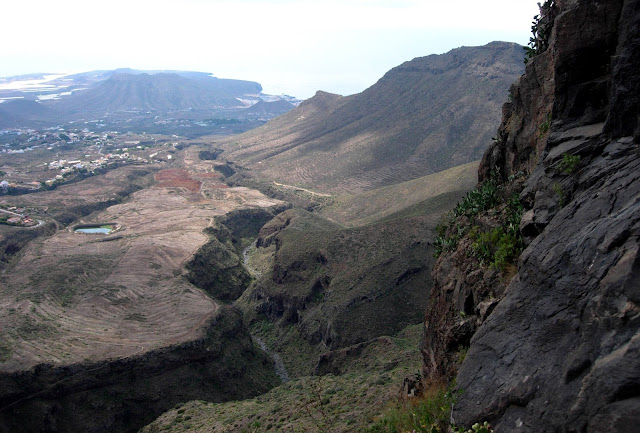Not too far from where I live in the south of Tenerife is the small hill town of San Miguel de Abona. Passing through the main street, it's easy to think that this slightly sleepy, fairly typical Canarian town has little of interest for those visiting the island but for anyone taking the time to leave the main road and investigate the narrow back streets, there is much of interest to be found.
 |
Salto del Pastor sculpture
|
Recently, in line with many other areas of the south, the walker is being catered for as numerous signposted hiking routes have sprung up, including two passing through San Miguel to Aldea Blanca. Even more recently, a town walk has been created taking the casual stroller on an interesting ramble around the back streets of the old part of the town, following newly installed information boards highlighting various points of interest to be found along the way. As you enter the town from San Lorenzo, you arrive at the Mirador de Las Palmeros, where you will find a map detailing the walk and marking points of interest. The mirador is easily identified by the unusual sculpture of a shepherd practising an ancient method of travelling quickly across steep, rugged terrain called Salto del Pastor, in which a large pole was used to negotiate steep slopes and ravines. This technique, which is believed to have been first been used by the Guanches, the islands original inhabitants, has now been developed into a folk-sport.
 |
| El Calvario |
From the mirador, the walk heads for El Calvario, in the old part of town, where you will find the La Casa del Capitan. This traditional old Canarian house belonged to the Alfonso family until the end of the nineteenth century and Miguel Alfonso Martinez achieved the highest military rank in the municipality, which is where the house gets it's name. After the house was devastated by fire, it was purchased and restored by the town and now houses an historical and ethnographic museum. The walk heads along the Calle de La Iglesia, towards the church square, following the route of an old Camino Real, or Royal Way, that once connected the towns of Granadilla, San Miguel, Aldea Blanca and San Lorenzo with the north of the island.
 |
| Calle de La Iglesia |
This camino would have once been used by vendors selling or trading goods from village to village as well as shepherds moving their herds. The walk now passes La Vieja Bodega, where you can join El Camino de Las Lajas, a 3.5 kilometre signposted hiking route to the village of Aldea Blanca. This is another camino that besides the normal traffic of shepherds and vendors selling wares, was also used as a 'corpse road' with the dead being transported from Aldea Blanca to San Miguel for burial. As you continue along the Calle de la Iglesia, you will pass a small alleyway, which was once the site of a gofio mill and a generator, which was installed in 1922, making San Miguel the first municipality in the south of the island to have electric street lighting.
 |
| House in the old part of San Miguel |
Eventually, the walk arrives at the attractive church square shaded by Indian laurels. From here, there are superb views down across the town to the south coast and you will also find benches where you can rest in the shade and enjoy the peaceful atmosphere.
 |
| Church in San Miguel |
Other buildings of interest in the square include the old library and birthplace of a famous Canarian, John Bethencourt Alfonso, a doctor, historian and anthropologist, who wrote 'The History of the Guanche People'.
Part two of the 'Crater to Coast Walk - Vilaflor to La Centinela' from 'Discovering Tenerife on Foot', follows the Camino Real from the Plaza de La Iglesia through the town to La Hoya and beyond to La Centinela.



























